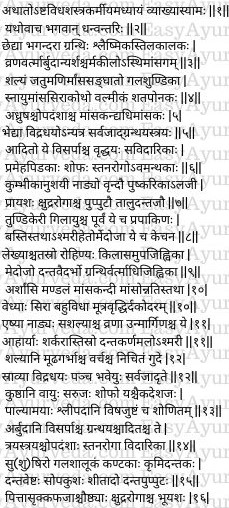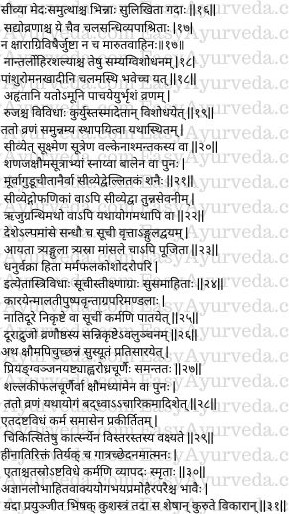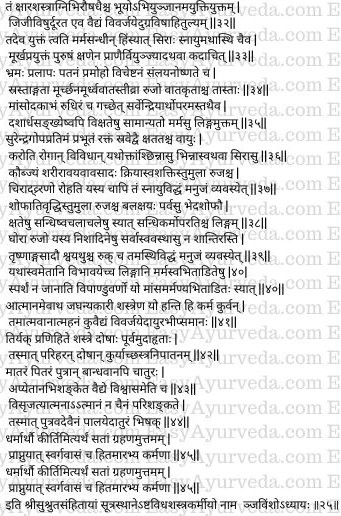This article explains Sushruta Samhita Sutrasthana Chapter 25 “Ashtavidha Shastra Karmiyadhyaya” – Eight kinds of surgical operations.
Ashtavidha Shastra Karma

Eight kinds of surgical operations
We will now expound the chapter by name Ashtavidha Shastra karmiya- the eight kinds of surgical operations; as revealed by the venerable Dhanvantari.
Read – Sushruta’s 8 Types Of Surgical Procedures – Ashtavidha Shastra Karma
- Chedya roga – Diseases requiring Excising
The diseases requiring excision i.e., diseases which can be treated by excision (cutting and completely removing) are –
- fistula-in-ano
- cystic swelling / tumors arising from Kapha
- black moles
- wounds (ulcers) / sinus ulcers
- tumors (ulcers of the eyelids)
- hemorrhoids
- warts of the skin
- foreign body lodged in the bones and muscles
- jatumani (birthmark, pigmented patch)
- mamsa sanghata (benign tumor of palate)
- enlargement of uvula
- putrefaction of ligaments, muscles and veins
- actinomycosis of the foot and
- sataponaka (a variety of rectal fistula
- Adhrusa
- ulceration of the penis
- mamsakanda
- adhimamsa
2. Bhedya roga- diseases requiring Incising / cutting open
The diseases requiring incision i.e., diseases which can be treated by incision (cutting open) are –
- all abscesses expect that produced by all the doshas together
- three kinds of cystic swellings / tumors (vataja, pittaja and kaphaja)
- the first three kinds of erysipelas (vataja, pittaja, kaphaja)
- all kinds of enlargement of scrotum (hernia)
- vidarika (pustule in groin and axilla)
- diabetic eruptions / carbuncles
- swelling (inflammatory)
- diseases of the breast
- Avamanthaka (disease of the penis)
- Kumbhika (follicular conjunctivitis)
- Anusayi (abscess of the foot)
- sinus ulcers
- the two kinds of vrnda (Vrnda and ekavrnda – small tumor of the throat)
- Puskarika (a disease of the penis)
- Alaji (inflammation of the penis)
- generally, all ksudra rogas (minor diseases)
- Talupupputa (tumor of the palate), Danta Pupputa (gingivitis)
- Tundikeri (tonsillitis)
- Gilayu (tonsillar abscess)
- those diseases which suppurate mentioned earlier
- the urinary bladder due to formation of calculus, and
- some diseases produced by fat tissue
3. Lekhana roga- diseases requiring Scraping
The diseases requiring scraping i.e., diseases which can be treated by scraping are –
- four kinds of rohini (vataja, pittaja, kaphaja, sannipataja)
- kilasa (leucoderma),
- upajihvika (swelling on the tongue)
- danta vaidarbha of fat origin (gingivitis),
- medaja granthi (fatty tumor),
- medaja vartma (fatty tumor of eyelids),
- adhijihvika (adenodis),
- arsas (hemorrhoids),
- mandala (a variety of leprosy),
- mamsakanda (small tumor of muscles) and
- mamsonnati (thickening of the muscles)
Read – Excision and Scraping – Chedana And Lekhana Karma In Eye Disorders
4. Vedhya roga – diseases requiring puncturing
The diseases requiring puncturing i.e., diseases which can be treated by puncturing are –
- siras (veins) to be punctured in many diseases,
- mutra vrddhi (enlargement of scrotum- hydrosol),
- dakodara (ascitis)
5. Esya roga – diseases requiring probing
The diseases requiring probing i.e., diseases which can be treated by probing are –
- nadi (sinus ulcers),
- sasalya vrana (wound with foreign body inside) and
- unmargi vrana (sinus ulcer which spread side wards)
6. Aharya roga – diseases required extraction / removal
The diseases requiring extraction / removal i.e., diseases which can be treated by extraction or removal are –
- three kinds of Sarkara – urinary gravel (vataja, pittaja, kaphaja)
- danta mala (tartar of the teeth)
- karna mala (ear wax)
- asmari (urinary calculi)
- salya (all kinds of foreign bodies)
- mudha garbha (impacted fetus) and
- feces accumulated in the rectum
7. Sravya roga – diseases requiring draining
The diseases requiring draining i.e., diseases which can be treated by draining (of blood, pus etc.) are –
- five kinds of vidradhi (abscess) except that born from all the doshas together,
- kustha (leprosy / skin disorders),
- saruja vayu (vata or vata conditions associated with pain)
- ekadesaja sopha (inflammatory edema confined to one place or one part of the body),
- palyamaya (diseases of the earlobe),
- slipada (filariasis),
- visajusta sonita (blood vitiated by poison),
- all kinds of arbuda – benign tumors
- visarpa – erysipelas
- the first three kinds of granthi (cysts, benign tumors)
- three kinds of upadamsa – syphilis (vataja, Pittaja, Kaphaja),
- stana roga (diseases of the breast),
- vidarika (pustule in groin and axilla),
- sausira (small sinus of the tooth),
- galasaluka (epiglotitis),
- kantaka (jihvakantaka / inflammation of tongue)
- krimidanta (caries of the teeth),
- danta vesta (gingivitis),
- upakusa (ulcerative gingivitis)
- sitada (spongy gums / scurvy),
- danta pupputa (gingivitis),
- ostha kopa arising from pitta, rakta and kapha (inflammation of the lips) and
- ksudra rogas (minor diseases) generally
Read – Madhava Nidana Chapter 39 Shlipada Nidanam
8. Sivya roga – Diseases requiring Suturing

The diseases requiring suturing i.e., diseases which can be treated by suturing are –
Contraindications for suturing
Diseases (wounds) caused by Alkali, fire and poison, those which emit air (gas) from inside, those having blood and foreign body inside should not be sutured but these should be well purified (removed of all accumulation).
Precautions before suturing
Sand, hairs, nails etc, pieces of bones which are left over moving inside the wound, when not removed will cause excessive suppuration of the wounds and cause many kinds of pains in the wound. Therefore, they should be carefully and completely removed and the wounds should be cleared / cleansed entirely.
Sivana vidhi – Sivana vastu
Procedure of suturing and materials
Next, the wounds should be elevated (raised up slightly), placed in the usual (normal) position and then sutured, with one or the other among the below mentioned things –
- thin thread of bark of Asmantaka, flax, jute, linen,
- ligaments,
- hairs,
- fiber of Murva or of Guduci
The type of suture may be Vellitaka, Gophanika, tunnasevani, Rujugranthi, or any kind as suitable or appropriate to the place.
Round needles (cylindrical and straight) of two angula in length should be used for suturing the places of the body which have less of muscles and also for suturing over the bony joints.
In the fleshy regions of the body i.e., body parts having more muscles, triangular (having three borders and straight) needles of four angulas in length are considered to be the best (ideal).
For suturing on vital points, scrotum and abdomen the needle should be curved like the bow.
In this way, suturing needles are of three kinds. The needles should have sharp points, manufactured in a precise way, and their hind tips should be rounded, resembling the stalk of malati flowers.
While using the needle (for suturing the edges of the wound), punctures should neither be made either very far or very near (from one hole to the other). If the punctures are far apart, that will give rise to pain in the edges of the wound and if very near, the edges will get torn.
After suturing has been done properly, the wound should be covered with linen and cotton and sprinkled with the powder priyangu, anjana (sauviranjana), yasti and rodha or of fruit or Sallaki or ash of linen cloth; then the wound should be bandaged appropriately, and the patient advised the regimen (of food activities) to be adhered.
Thus, the eight kinds of surgical operations were described in brief; these will be described in detail in Chikitsa sthana (section IV).
Read – Methods Of Surgical Training Elaborated In Ayurveda
Sastra Karma Vyapat

Complications of surgery
In these eight kinds of operations, four kinds of complications might occur. They are –
- hina cheda (inadequate cutting)
- atirikta cheda (excess cutting),
- tiryak cheda (oblique / improper cutting) and
- atmana cheda (cutting of own body, fingers etc. of the physician himself, accidentally)
When the physician performs surgical operations improperly (using improper or bad instruments), due to either ignorance, greed, inciting words of others, fear, delusion (confusion) or any other factors, then he creates many other diseases.
The person desirous of living, should reject (avoid) even at a distance that physician who administers the treatment using alkalies (cautery), sharp instruments (surgery), fire (thermal cauterization) and drugs (medicines) in improper manner, just like avoiding a highly poisonous serpent.
That (instrument) itself, made use of by the foolish physician (in a wrong way), produces severe pain in the vital points, joints, veins, ligaments and bones and sometimes even causes loss of life.
Read – Procedure of surgical operation: Ashtanga Hrudaya Sutrasthana 29
Sastrakarma Vyapat Laksana
Symptoms of complications of surgery
Giddiness, delirium, fainting, delusion, loss of activity of the body parts, semi-consciousness, increase of body temperature, weakness of body parts, fainting, vata abnormally moving upwards / increased expirations, severe pain caused by vata, blood resembling mutton wash flowing out, cessation of activity of all the sense organs — are the common symptoms when all the five (vital spots, Joints, veins, tendons, and bones) are injured (by the knife), especially the vital spots.
When the veins are cut or torn there will be profuse bleeding from the wound, the blood resembling indragopa (cochineal insect which is bright red in color). Vata getting aggravated due to this gives rise to many diseases.
Symptoms of cut or injury to the ligaments include –
- shortening (of the body)
- debility of body parts
- inability to perform their actions
- severe (excruciating) pain
- wound (of the knife) healing after a long time
Symptoms of injury to the movable or immovable joints include –
- great increase of swelling,
- very severe pain,
- loss of strength of the joints;
- blasting / splitting pain and edema in the small joints of fingers and toes and
- loss of function of the joints
Symptoms of cut or injury in the bones include –
- severe pain day and night (constantly),
- finds no comfort in any position (postures),
- thirst,
- weakness of the body,
- edema and
- dryness
Symptoms of injury of vital spots (related to veins, ligaments, bones and joints) include the above symptoms also should be included (along with others concerned to the particular vital spots).
Symptoms of injury of vital spots related to muscles include –
- loss of sensation of touch,
- profound yellowish white color of the body
The physician who causes injury by his instruments while performing his activities should be considered as a mean fellow; the intelligent person, desirous of long life, should avoid such a quack physician who kills (the patient).
The hazards occurring due to improper use of instruments have been described earlier (chapter- 5) hence instrumentation (surgical operation) should be performed avoiding those hazards.
Read – Marma Shaareera: Definition, Composition: Vital Points of The Body
Aturva visvasa
Faith of the patient
The patient might suspect his own mother; father, sons or relatives but reposes faith in the physician and submits himself to him (the physician) and does not suspect him. Hence the physician should protect the patient like his own son.
The physician by his efficacious actions (surgery) earns –
- righteousness (merits),
- wealth, and
- reputation,
- great respect from the wise and
- even life in heaven
Some diseases get cured by any one kind of treatment only, some by two, some by three, and some others by four kinds (of treatments).
Thus ends the Twenty-fifth chapter by name Ashtavidha Shastra Karmiya in Sutra Sthana of Susruta Samhita.

